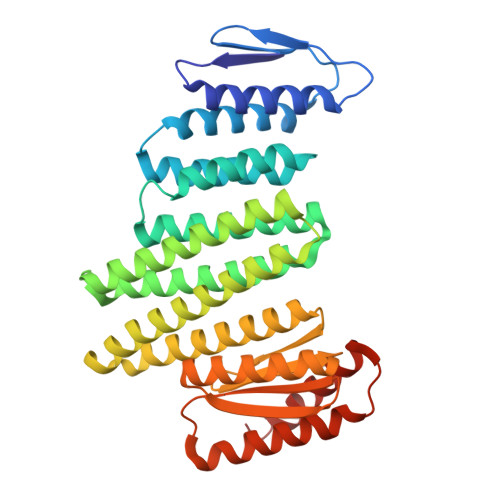De novo design of allosterically switchable protein assemblies.
Pillai, A., Idris, A., Philomin, A., Weidle, C., Skotheim, R., Leung, P.J.Y., Broerman, A., Demakis, C., Borst, A.J., Praetorius, F., Baker, D.(2024) Nature 632: 911-920
- PubMed: 39143214
- DOI: https://doi.org/10.1038/s41586-024-07813-2
- Primary Citation of Related Structures:
8UP1, 8URE, 8UTM - PubMed Abstract:
Allosteric modulation of protein function, wherein the binding of an effector to a protein triggers conformational changes at distant functional sites, plays a central part in the control of metabolism and cell signalling 1-3 . There has been considerable interest in designing allosteric systems, both to gain insight into the mechanisms underlying such 'action at a distance' modulation and to create synthetic proteins whose functions can be regulated by effectors 4-7 . However, emulating the subtle conformational changes distributed across many residues, characteristic of natural allosteric proteins, is a significant challenge 8,9 . Here, inspired by the classic Monod-Wyman-Changeux model of cooperativity 10 , we investigate the de novo design of allostery through rigid-body coupling of peptide-switchable hinge modules 11 to protein interfaces 12 that direct the formation of alternative oligomeric states. We find that this approach can be used to generate a wide variety of allosterically switchable systems, including cyclic rings that incorporate or eject subunits in response to peptide binding and dihedral cages that undergo effector-induced disassembly. Size-exclusion chromatography, mass photometry 13 and electron microscopy reveal that these designed allosteric protein assemblies closely resemble the design models in both the presence and absence of peptide effectors and can have ligand-binding cooperativity comparable to classic natural systems such as haemoglobin 14 . Our results indicate that allostery can arise from global coupling of the energetics of protein substructures without optimized side-chain-side-chain allosteric communication pathways and provide a roadmap for generating allosterically triggerable delivery systems, protein nanomachines and cellular feedback control circuitry.
- Department of Biochemistry, University of Washington, Seattle, WA, USA. apillai1@uw.edu.
Organizational Affiliation:
















